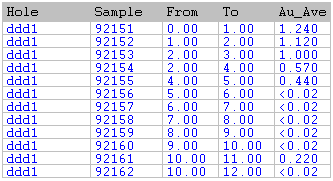Interval file
An Interval file contains information collected at intervals down a drillhole. Typically this is lithological or assay data. The minimum contents of each record in an Interval file are:
Hole ID
A field containing an identifier for each hole.
From and To
From and To fields which define each interval down the hole.
Other Fields
Information about each From/To interval, such as a Sample number, Assay value, Lithology etc.

Downhole data can have many forms depending on what is being sampled or measured. As a general principle, data with different sample intervals should be kept in separate files. For example, assay and lithological information are normally kept separately.
Assay data is usually supplied from the assay laboratory as a column delimited ASCII file. The assays in this file have a sample number. By matching the sample number in the Assay file with the same field in the incomplete Interval file, you can merge the assay values into the Interval file. Do this using the Merge tool in the File Editor (Select Tools | Merge | Text from the File Editor menu).
The Interval file in the next illustration contains lithological data. In this case the user wants to calculate the 3D coordinates of each sample interval so has created Northing, Easting and Z fields.

All holes in the Interval file must have a reference in the Collar file.
The total depth of a drillhole is defined in the Collar file. Any samples in the Interval file below this depth will cause an error.
All information for a drillhole must be in consecutive records and be sorted in order of increasing depth.
A drillhole does not need to have intervals defined along the complete depth (i.e. from 0 to total depth). You only need intervals where you have lithological observations or samples.
For more information, refer to the Sample intervals in Interval files topic.